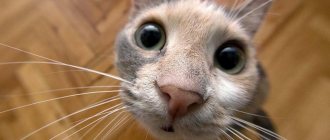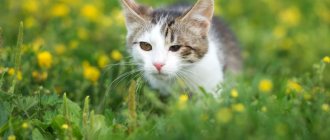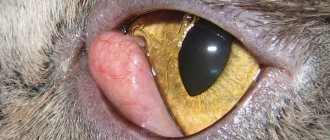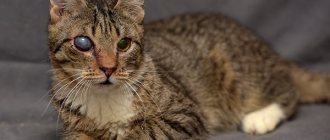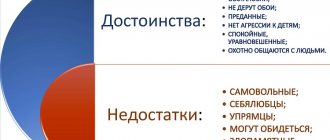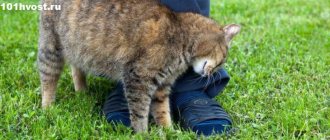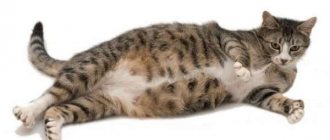How to cure a British kitten whose eyes are watery?
So, we note the most basic reasons why a British kitten’s eyes become watery:
- Worms in the kitten's body.
Anthelmintics are the first treatment vets use when they notice tearing in Britons. You may also be advised to get tested, but you should never refuse, because not all problems are visible outwardly even to qualified specialists.
- Closed tear ducts.
This feature is due to the breed of British cats. The flattening of a kitten's muzzle can provoke a narrowing of the tear ducts (if you understand medical terms, this is due to the special structure of the cranial-maxillary bones). The absence of fever and a normal appetite in the kitten will allow you to be calm.
Often allergic reactions are associated with inappropriate feed composition.
- Reaction to fluorescent light.
It is indeed a proven fact that cats can have watery eyes in rooms with fluorescent lamps.
- A banal reaction to house dust.
The protruding membrane on the eyes of British cats can cause allergic reactions to dust, so do not be lazy to do wet cleaning to keep your kitten healthy. And this will also benefit your household, because people are increasingly becoming allergic to house dust.
If you choose the wrong food for your kitten, then in addition to indigestion and stomach problems, you can lead to an inflammatory process in its intestines. Be careful and careful, because this is fraught with consequences.
Having ruled out all of the above causes of tearing, still try to give the kitten anthelmintic drugs and then use these little instructions.
General recommendations
We test all the products on ourselves before we give them to the kitten. Yes, that’s right, if you don’t have any abnormal reactions, then this remedy will be suitable for a kitten. Also, be sure to thoroughly understand the problem, is it really tearing or is it rotting eyes?
If you have determined for sure that this is a simple discharge of tears from the eyes, which is typical for little Britons, then try to carry out comprehensive first aid for your little “fluffy”.
Simple remedies
- If the tears are not very profuse, then try rinsing with just water or tea.
- Brew your kitten a decoction of chamomile, sage, St. John's wort or calendula herbs. Moreover, the following features must be taken into account:
- sage is used to eliminate dryness that can occur in the morning in the British;
- chamomile fights well against conjunctivitis, primary suppurations (i.e. not advanced);
- calendula will be useful if the kitten has an allergic reaction to something;
- The microbial and viral environment is best killed by decoctions of St. John's wort; the remedy is quite effective and accessible to everyone.
Treatment with herbal decoctions should be carried out as follows: wash your hands thoroughly, take a clean cotton swab and start wiping the eyes from the outer corner to the inner, then take a new swab and repeat the procedure until the problem is completely eliminated.
- Use a solution of potassium permanganate, furatsilin (1:10), albucid or sodium sulfacyl. Side effect: The fur around the eyes may darken from the medications.
- If you apply tetracycline ointment at night, the improvements will be clearly visible. Place tampons with ointment behind your eyelids. This way you will get rid of the infection.
- On the shelves of veterinary pharmacies you can also find products such as “Iris” and drops based on chloramphenicol.
- Your kitten can also benefit from Diamond Eyes drops. The basis of this drug helps to help with your problem in the shortest possible time.
- Hygienic lotions such as “Phytoelite” can replace herbal decoctions; their principle of action is similar, you just don’t need to spend time preparing them.
It sometimes happens that the cat was at home all the time, did not go out, but his eyes began to run or began to fester. Among breeders of British cats, the problem is not new, widespread and requiring immediate intervention from the owner. People often wonder “why do the British get watery eyes, what makes them watery, and for what reason.” I’ll tell you plenty of reasons, and now we’ll talk about them in order.
First of all, let's note the fact that British cats in many cases can have watery eyes due to the physiological features of the structure of the head. This feature causes changes (shortening) in the nasolacrimal ducts. It is because of this feature that, as a rule, the eyes of British people at a young age become watery, and if the eyes are watery with a slight discharge from the mucous membrane, then there is nothing to worry about. Everything should go with the further development of the kitten.
The next reason for the appearance of tears in your pet may be Worms. As it turned out, some types of worms can cause lacrimation in kittens. As a rule, when you contact a veterinary clinic, you will be advised to undergo tests and be given anti-helminth medication.
Allergies can also be an important cause for inflammation of the mucous membrane. Your new perfume, household chemicals, dry food, and no matter how trivial it may seem, pollen can cause an allergic reaction in a kitten or adult cat.
A much more serious cause could be infection or mechanical damage to the eye.
Your pet could somehow injure his eye while playing, or some small speck could get into it. This type of injury can be very dangerous and in such cases it is best to contact a veterinarian immediately. Only a specialist can assess the extent of damage and prescribe the correct treatment. As for viral diseases, there are a lot of them, the etiology of which is expressed precisely in lacrimation, and now there is no point in listing all of them.
We suggest you read: Bleeding from a cat’s nose: reasons why it bleeds, what to do
We have found out why British cats have watery eyes and now let’s find out what should be done when a kitten’s eyes start to run.
Taking into account the main reasons, you can try to take measures to eliminate them.
- Brew chamomile petals in a steam bath, cool and wash the kitten 2-3 times a day. You can also wipe your eyes with a weak solution of potassium permanganate.
- If a British cat has conjunctivitis, then antimicrobial agents should help. You can put eye ointment under your eyelids at night.
- If a kitten has mechanical damage, breeders and owners often use “Iris” and Levomecithin drops, and “Diamond Eyes” and Albucid (human pharmacy) drops have also shown good results.
- In cases where purulent discharge appears in the eyes, it is worth trying a decoction of: calendula, sage, chamomile, St. John's wort. An industrial substitute for this decoction is the “PhytoElite” eye lotion, designed specifically for the care of cats with eye diseases.
You should not experiment on your pet’s health, and if you are not sure about the cause of the disease, it is better to consult a specialist. The sooner proper treatment begins, the sooner your Briton will recover.
For various reasons, cats' eyes often begin to fester. This may indicate either an eye disease or a serious illness in the animal. The owner of every pet should know how to treat a cat and how to find out the cause of eye infection.
If you don’t know how to treat a cat’s eyes, then read this article.
In this article, you will get acquainted with the most common causes of eye suppuration and methods of treating this disease.
Many pet health problems can be prevented by following simple rules for care and maintenance. A cat's eyes can signal many ailments, and therefore require care and attention from the pet owner.
The animal must be protected from bright lighting, household chemicals and various aerosols. Cleaning and other manipulations with similar substances should be carried out in the absence of the cat, isolating it in another room. Even the use of toilet water causes irritation or an allergic reaction, especially if the pet is very small. The attentive attitude and care of the owner will allow the cat to avoid many health problems.
Prevention of lacrimation and hygiene of kitten eyes
Many pet health problems can be prevented by following simple rules for care and maintenance. A cat's eyes can signal many ailments, and therefore require care and attention from the pet owner.
It is very important to monitor the cleanliness of the kitten’s vision organs and regularly wash them with special solutions. You can make them yourself at home or purchase them ready-made at a pharmacy or pet store. In case of inflammation or other alarming symptoms, you need to show the animal to a specialist. Treatment of the disease at an early stage of development is much simpler, and correctly selected drugs can reduce its duration.
The animal must be protected from bright lighting, household chemicals and various aerosols. Cleaning and other manipulations with similar substances should be carried out in the absence of the cat, isolating it in another room. Even the use of toilet water causes irritation or an allergic reaction, especially if the pet is very small. The attentive attitude and care of the owner will allow the cat to avoid many health problems.
Treatment of eye suppuration according to the recommendations of a veterinarian
Once the veterinarian determines the cause of the pus discharge from the pet's eyes, he will prescribe the appropriate treatment.
- If the kitten develops swelling, then in this case it is necessary to use a solution of hydrocortisone and novocaine.
- If the pet experiences severe pain, then it is necessary to use a novocaine blockade with an antibiotic. This drug can not only reduce pain, but also relieve the inflammatory process.
- If an animal has an advanced disease, the veterinarian will prescribe a course of antibiotic therapy by injection.
- If pus is released from the eyes after an injury or a foreign object, then the animal must use drops of Levomycetin or Iris.
Any of the above drugs should be used only after consultation with a veterinarian. Self-medication can cause the kitten to lose sight.
This problem often occurs in cats of various breeds. At a young age, this is sometimes the norm, especially if the kitten was separated from its mother too early. A small pet does not yet know how to carefully care for itself, which leads to increased tearing and accumulation of dirt. In this case, he requires daily help from his owner.
Some purebred cats suffer from narrowing of the tear duct, this is considered normal before the age of 2 years. The lacrimation disappears after the kitten's skull is completely formed. Most often, the problem occurs in a British or Persian pet, or a Scottish fold cat. It is very important to monitor the general condition of the animal and its eyes, treating them regularly.
If the tears are not too abundant, it is recommended to simply rinse your eyes with strong tea. You can also use decoctions of the following herbs:
- Sage. The infusion is recommended for use when morning purulent crusts form on the eyes of the animal.
- Calendula. The herb relieves allergic lacrimation.
- Chamomile. The decoction will help in the initial stage of conjunctivitis, when there is still no suppuration.
- St. John's wort. The herb has proven itself to be effective against microbial or viral causes of lacrimation.
If the composition of the tears begins to resemble pus, then you can use the following drugs:
- Potassium permanganate solution.
- Furacilin tablets diluted in boiled water in a ratio of 1:10.
- Eye drops "Albucid" or "Sodium Sulfacyl".
- Tetracycline ointment if watery eyes are caused by an eye infection. In this case, tampons with ointment must be placed behind the animal’s eyelids. Improvement occurs quite quickly.
- Drops with chloramphenicol.
- The drug "Iris".
- For kittens, it is recommended to use “Diamond Eyes” drops.
- Hygienic lotions can replace herbal infusions.
Pollution and mechanical damage to the eye area
This problem often occurs in cats; debris, dust and other foreign particles get into their eyes. A pet can damage its eye with grass, a branch, during a fight or play. All this is accompanied by severe lacrimation, sometimes the discharge turns brown, which indicates an infection. It is best to contact a specialist, but it is not always possible to do this in the near future. You can provide first aid to an animal at home by following some rules.
- 1. If a cat’s eye is tightly closed, you cannot open it for treatment yourself, as this can cause even more harm. The treatment is performed extremely carefully and only in the area around the organ of vision.
- 2. With normal lacrimation, you need to examine the cat's eye for a foreign body. It can be removed by abundant rinsing, using a pipette or syringe without a needle; it must be kept at a safe distance from the eyeball (at least 1-1.5 cm). After cleansing, use tetracycline ointment 1% before visiting the veterinarian. The ointment should be carefully placed under the pet’s upper eyelid; blinking will distribute it evenly.
- 3. It is not always possible to notice the wound yourself, so if there are no external signs of damage, you just need to treat the eye with a solution. If there are no other alarming symptoms, but lacrimation continues, tetracycline ointment 1% is used.
- 4. After injury, swelling or enlargement of the eye often occurs; the animal is unable to close its eyelids completely, which leads to dry cornea. In this case, you need to regularly drip clean boiled water, the temperature should not exceed 36.6 degrees. Sometimes treatment is required almost every 5-7 minutes; you need to contact the clinic immediately.
- 5. If the color of the discharge changes to dark, you need to clean the cat’s eyes and contact a specialist. This occurs due not only to damage, but also to many other diseases that require complex treatment.
Proper eye hygiene for your pet can avoid many problems. Inflammations often occur due to the ingress or accumulation of dirt. Timely cleansing of the animal’s visual organs can eliminate complications and long-term treatment.
Processing rules
If a kitten's eyes are watery, it is necessary to establish the cause of the ailment, but first cleanse the organs of vision. Performing this procedure at home is quite simple. The first time it is better to act with an assistant who will hold the animal tightly. It is better to wrap the cat in a towel or blanket, this way it is easier to immobilize it and avoid injury.
The following solutions are most often used for cleaning:
- moderately strong tea, it is better to use green tea, since the black variety causes dryness of the cornea. It should be leafy and brewed no more than 10-12 hours ago;
- chamomile infusion, you need 1-2 teaspoons per 200 ml of water, leave for 10 minutes, after which you need to cool the solution and strain thoroughly;
- infusion of calendula, hyssop or St. John's wort, infused in the same dosage;
- furatsilin solution, sold ready-made or diluted 2 tablets per glass of boiled water until completely dissolved;
- boric acid solution, 1 teaspoon per 250 ml of water is needed, mix thoroughly;
- saline;
- clean boiled water;
- drops and special products, Diamond eyes.
We suggest you read: The cat does not eat anything. Why does a cat refuse food and drink for several days: what to do
Rinse your eyes with a cotton swab or gauze; ordinary cotton wool is not recommended for use, as the lint can cause irritation. All manipulations are carried out from the outer eyelid to the inner one. First, you need to generously moisten the cat’s eyes and the area around them, carefully remove all accumulated dirt and crusts.
Movements should be carried out easily, without exerting strong pressure. Do not touch the eyeball or use a dry swab for cleansing. After these manipulations, you need to open the cat’s eye, drip the solution inside and bring the eyelids together. This will process the entire inner surface. After completing the procedures, it is better to take pity on your pet or treat it to your favorite food.
When treating your eyes, hygiene is very important. The procedure is carried out only with clean hands. Both eyes are always treated, even if only one is affected. Remember to use a new cotton swab to wash your eyes each time. The movement always starts from the outer corner of the eye towards the inner.
The British cat is the most common breed among purebred cat lovers. Like all pets, she requires special care and attention. Pedigree cats are more susceptible to various ailments than anyone else. One of these is the problem of watery eyes.
Why do British cats have watery eyes? There can be many reasons. Let's look at everything in order.
To do this, you will need ear sticks or cotton pads. Moisten this or that device with a specific solution that you selected for your cat. Wipe the eye from the corner that is closer to the outside to the side of the corner that is inside. During this procedure, it is necessary to remove all discharge, and then repeat it over a clean eye.
In general, healthy kittens should have clean eyes, the only thing is that there may be discharge after sleep, which the kitten must deal with on its own. Therefore, if you notice that your pet has discharge from his eyes throughout the day, if he squints, rubs them, or if his eyes are swollen, perhaps reddened around, then this is an alarming signal. And, of course, in this case it is best to contact an experienced and trusted veterinarian!
Pollution and mechanical damage to the eye area
This problem often occurs in cats; debris, dust and other foreign particles get into their eyes. A pet can damage its eye with grass, a branch, during a fight or play. All this is accompanied by severe lacrimation, sometimes the discharge turns brown, which indicates an infection.
- 1. If a cat’s eye is tightly closed, you cannot open it for treatment yourself, as this can cause even more harm. The treatment is performed extremely carefully and only in the area around the organ of vision.
- 2. With normal lacrimation, you need to examine the cat's eye for a foreign body. It can be removed by abundant rinsing, using a pipette or syringe without a needle; it must be kept at a safe distance from the eyeball (at least 1-1.5 cm). After cleansing, use tetracycline ointment 1% before visiting the veterinarian. The ointment should be carefully placed under the pet’s upper eyelid; blinking will distribute it evenly.
- 3. It is not always possible to notice the wound yourself, so if there are no external signs of damage, you just need to treat the eye with a solution. If there are no other alarming symptoms, but lacrimation continues, tetracycline ointment 1% is used.
- 4. After injury, swelling or enlargement of the eye often occurs; the animal is unable to close its eyelids completely, which leads to dry cornea. In this case, you need to regularly drip clean boiled water, the temperature should not exceed 36.6 degrees. Sometimes treatment is required almost every 5-7 minutes; you need to contact the clinic immediately.
- 5. If the color of the discharge changes to dark, you need to clean the cat’s eyes and contact a specialist. This occurs due not only to damage, but also to many other diseases that require complex treatment.
Proper eye hygiene for your pet can avoid many problems. Inflammations often occur due to the ingress or accumulation of dirt. Timely cleansing of the animal’s visual organs can eliminate complications and long-term treatment.
Treatment of eye suppuration according to the recommendations of a veterinarian
Cats' eyes can fester for various reasons, and here are the most common ones:
- Conjunctivitis is the most common cause of eye infection in animals. This disease is very easy to cure; the most important thing is not to let it get worse.
- Trauma to the mucous membrane can also cause suppuration of the eye. Small wounds on the animal heal on their own, but larger ones should be treated.
- Blepharitis is a dangerous eye disease in cats that can occur as a result of a chemical burn or injury.
- Keratitis is an inflammation of the cornea that leads to suppuration of the eye.
- Due to poor health and low immunity, the animal's eyes may fester.
- Also, cats' eyes can fester due to poor nutrition.
- As a result of a “dirty nest”, the cat’s eyes may fester.
- If the kitten is hypothermic, it may develop purulent discharge from the eyes.
- Heredity.
Infectious and other diseases
Serious illnesses often have many manifestations: in addition to discharge from the eyes, the cat often has a runny nose and sneezes. The pet may refuse to eat, become lethargic and inactive. Only a specialist can help the animal, who will identify the exact cause and prescribe a treatment plan. A kitten's lacrimation occurs as a result of:
Most often, cats are exposed to conjunctivitis; the disease develops gradually, but with complications it also affects other organs except the visual ones. Treatment begins with washing the eyes with a cleansing solution and contacting a specialist. The doctor will prescribe the most effective drug, and you can rid your animal of the disease at home. Antibiotic containing drugs are prescribed:
- sofradex;
- Tevomycetin;
- tetracycline.
For additional therapy, drops containing silver are used, such as Cliny Eye Cleansing Lotion. Treatment should include both eyes, even if one is healthy. Self-medication with such a diagnosis can worsen the animal’s condition. The disease has different pathogens, depending on which drugs are selected.
- Prazitel;
- Drontal;
- Celandine;
- Pratel;
- Dirofen;
- Vacation.
The specialist may prescribe other medications. When you get rid of the main cause of lacrimation and other ailments, the symptoms themselves disappear. During the treatment period, your pet's eyes require careful attention, regular washing and disinfection.
First aid for a pet at home
When a pet gets sick, accompanying symptoms immediately appear. If the owner notices one or more of the following signs of disease in the kitten, he needs to urgently contact a veterinarian.
- The pet has become aggressive and angry, very often rubbing its eyes with its paw:
- The kitten refuses to eat and sleeps poorly;
- In the light, the pet closes its eyes and tries to stay in a dark corner;
- Increased body temperature;
- The eyes water, become red, and purulent formations flow out of them;
- The fur takes on a brownish tint after about a century.
There are situations when it is impossible or very difficult to get to the veterinarian. In this case, the owner must provide first aid to his pet.
- Washing your eyes is a very important aspect. By washing your eyes, you relieve your baby's suffering. Eyes should be washed only with a warm solution using a cotton pad. After rinsing, your pet should apply an eye ointment, such as tetracycline.
Washing is performed by the following means:
- A decoction of medicinal chamomile;
- Boric acid solution;
- 0.02% furatsilin solution.
- Eye ointment. Before applying the ointment, you need to warm it in your hand. Cold ointment should never be applied to the affected area.
Breed-specific eye diseases
Eye pathologies are more common in children and adolescents. Short-faced, smooth-haired cats are predisposed to the following eye diseases:
- Prolapse of the third eyelid.
Inflammation of the conjunctival sac is caused by the following reasons:
- allergic reaction;
- helminthic infestation;
- infectious diseases.
Crying in British and Scottish Fold cats can be caused by blocked tear ducts. It occurs due to the structural features of the muzzle. You need to contact a veterinarian as soon as possible: if treatment is not started in a timely manner, purulent complications are possible, which will be much more difficult to get rid of. The pathology may be accompanied by decreased appetite, increased body temperature, lethargy, and apathy.
British kittens need proper nutrition from early childhood; The diet must be balanced, the products must be of high quality. If the food is not suitable, there may be problems with the intestines (constipation, diarrhea, vomiting), accompanied by lacrimation. The animal's menu should be changed; To select the right one, it is better to consult a veterinarian.
Why are the Britons constantly in tears?
The ointment should be applied as follows:
- The kitten should be placed on its side and held tightly. It is best if one person holds the pet while the other applies the medicine.
- Next, you need to carefully pull back the lower eyelid and gently apply the ointment.
- Then, you should massage the eyelid so that the medicine is distributed over the eye.
- You can also put special drops in your pet’s eyes. Which ones you need to find out at your veterinary pharmacy.
Treatment
To begin with, you should determine the nature of the discharge: whether it is purulent and whether there are accompanying symptoms. You should immediately take your pet to the veterinarian if:
- occurrence ; temperature rise; lack of appetite and lethargic behavior.
To reduce cat tearfulness, the following actions are taken:
It is necessary to regularly wipe your eyes with herbal decoctions or a mixture of boiled water and potassium permanganate or tea leaves. If the wool is light in color, then this procedure will turn it brown - this does not pose a danger. Tetracycline ointment is a universal antimicrobial drug. It is applied at night, spreading a small amount onto the eyelids. Use “Iris” eye drops: a couple of drops are dripped into each visual organ, and then the leaked residue is wiped dry. It is important to ensure that the cat does not start scratching them, otherwise irritation will begin.
Before using ointments and drops, you should first consult with your veterinarian so as not to aggravate the disease with incorrectly selected treatment.
Causes of excessive tear production
Age
Excessive tearfulness is generally characteristic of small kittens, especially babies whose eyes have just opened. Often they are licked by the mother cat. If the eyes of a kitten that has already been weaned from its mother are watery, do not worry. Usually, with age, the secretion of fluid stops. In case of excessive production of tears and sticky eyelids, wipe the kitten’s eyes twice a day with a cotton swab dipped in warm boiled water. This should be done with extreme care and caution.
If a kitten's eyes are watery, this may also indicate a weakened immune system. Since any vaccinations are generally contraindicated for kittens under 2 months of age, tears can be a symptom of the presence of worms or other parasites in the body.
We suggest you read: A cat peeing in blood: what is the reason for its presence in the urine and how to treat the animal
The reason for your pet's frequent tears may also be due to the characteristics of its breed. So the muzzle of a Scottish fold cat is short and snub-nosed. At the same time, the tear ducts are too short. Thus, tearing occurs with any slightest irritation.
Persians may have watery eyes because representatives of this cat breed have a very short muzzle in addition to large bulging eyes. Motes, dust and infections plague Persian cats more than others.
If your Scots or Persian's discharge is clear and not profuse, it should be perceived as a characteristic of the breed and constantly take care of the condition of your pet's eyes.
Don Sphynx cats may have congenital entropion of the eyelids, often resulting in watery eyes as the cornea scratches against the eyelashes. And although not every Sphynx cat suffers from this defect, nevertheless, if pathology occurs, surgery is required.
Conjunctivitis
The cause of watery eyes may be a bacterial or viral infection that causes the cat's eyes to become swollen. But only a doctor can say this for sure after a special examination of the furry patient. Once the diagnosis is confirmed, your purr will be prescribed anti-inflammatory and antibacterial medications.
Allergy
A purr's watery eye may also indicate an existing allergy. Here, the causative allergen can be people, chemicals, food, pollen, dust or hair hanging on the cat’s eyelids. Caring owners will need to determine the specific cause of the allergy and protect their pet from contact with the pathogen.
Worms
Why are my kitten's eyes watering? The cause may also be common worms. In this case, the veterinarian will recommend anthelmintic prophylaxis.
Cats’ eyes also become watery due to rhinotracheid, calcivirosis, chlamydia, as well as other diseases that are extremely dangerous for both cats and their owners. To avoid these diseases, it is advisable to vaccinate the animal in a timely manner. We should especially talk about rabies, which is characterized by excessive drooling and tears, fear of water, and an aggressive or lethargic state.
Eye diseases
Representatives of the cat family can suffer from cataracts and glaucoma.
Cataracts are characterized by clouding of the eye lens. Treating it is quite difficult, but necessary. Otherwise, the purr faces complete blindness. Cataracts occur due to head and eye injuries, metabolism, diabetes, exhaustion and some chronic diseases. It is quite difficult to identify this disease at an early stage. In the later stages, the cat experiences deterioration in vision, production of tears and clouding of the eyes.
Glaucoma affects cats with impaired outflow of intraocular fluid and increased intraocular pressure. Four-legged patients are depressed, often “cry” and are afraid of light. There is redness of the visual organs and dilation of the pupils.
If injured, your cat's eyes may become swollen. Tears in this case indicate the healing process. Contact the veterinary clinic and they will always tell you how to treat your furry pet. Most likely, the doctor will prescribe Cornegerel drops, which will moisturize the eyes well and help in the healing of small wounds.
Treatment
Only specialized veterinary clinics can tell you the correct answer to the question: why do cats’ eyes water and how to treat this disease? Here they will accurately identify all the causes of eye problems and prescribe the appropriate treatment.
Infectious and other diseases
Most often, cats are exposed to conjunctivitis; the disease develops gradually, but with complications it also affects other organs except the visual ones. Treatment begins with washing the eyes with a cleansing solution and contacting a specialist. The doctor will prescribe the most effective drug, and you can rid your animal of the disease at home. Antibiotic containing drugs are prescribed:
- sofradex;
- Tevomycetin;
- tetracycline.
For additional therapy, drops containing silver are used, such as Cliny Eye Cleansing Lotion. Treatment should include both eyes, even if one is healthy. Self-medication with such a diagnosis can worsen the animal’s condition. The disease has different pathogens, depending on which drugs are selected.
- Prazitel;
- Drontal;
- Celandine;
- Pratel;
- Dirofen;
- Vacation.
The specialist may prescribe other medications.
When you get rid of the main cause of lacrimation and other ailments, the symptoms themselves disappear. During the treatment period, your pet's eyes require careful attention, regular washing and disinfection. READ TOP 10 reasons for a cat to miscarry
Intestinal problems
Having considered all the causes of watery eyes in British cats, draw conclusions and be sure to help your pet.
This problem is rare, but it still exists. Therefore, when you see that your kitten has begun to suffer from flowing tears, you should pay close attention to this. However, before taking any measures, we advise you to re-read the articles about what are the causes of this problem.
If you have ruled out all possible causes and also given the kitten prophylaxis against worms, then you can try to help your Briton on your own. However, it is worth remembering that it is best to consult a veterinarian before dealing with this problem in your pet.
This is a mandatory point, because if you do not experience any irritation or worsening, then this remedy can be used on an animal.
Another important point! Determine whether your pet’s eyes are watery or festering, because these are two completely different things.
So what can you do if your kitten suffers from lacrimation?
Fluorescent lamps
Cat's eyes are very delicate, so when exposed to bright indoor lighting using fluorescent lamps, a British cat may develop some kind of acute conjunctivitis. The solution is to change the lighting in the room, and also put drops in the cat’s eyes.
A reaction to dust is a type of allergy. But drugs won't help here. To alleviate the suffering of the animal, drip special drops, and also be sure to monitor the amount of dust in the room. By reducing its amount to a minimum, you will help your Briton.
Disease prevention
In order for your pet to get sick less often, he needs to take preventive measures, namely:
- A small pet should wash its eyes daily;
- When playing with an animal, it is necessary to take all measures so that the kitten does not get injured;
- All vaccinations must be done on time;
- The animal's nutrition must be correct and balanced;
- Take your pet to the vet regularly.
Caring for your pet is a very important aspect of pet care. After all, this is the only way your baby will grow up healthy and happy.


